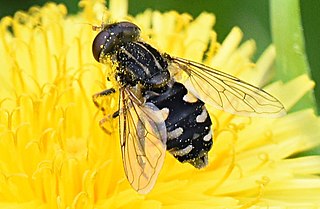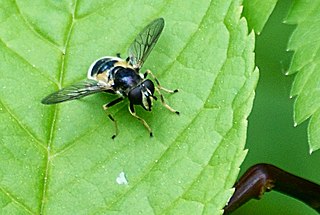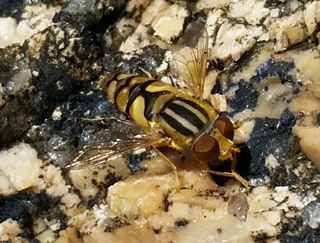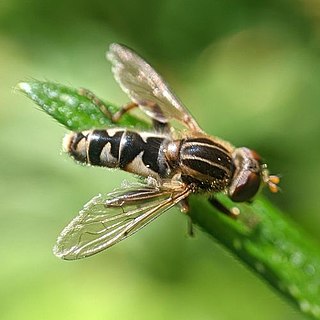
Hoverflies, also called flower flies or syrphids, make up the insect family Syrphidae. As their common name suggests, they are often seen hovering or nectaring at flowers; the adults of many species feed mainly on nectar and pollen, while the larvae (maggots) eat a wide range of foods. In some species, the larvae are saprotrophs, eating decaying plant and animal matter in the soil or in ponds and streams. In other species, the larvae are insectivores and prey on aphids, thrips, and other plant-sucking insects.

Syritta pipiens, sometimes called the thick-legged hoverfly, is one of the most common species in the insect family Syrphidae. This fly originates from Europe and is currently distributed across Eurasia and North America. They are fast and nimble fliers, and their larvae are found in wet, rotting organic matter such as garden compost, manure, and silage. The species is also commonly found in human-created environments such as most farmland, gardens, and urban parks, wherever there are flowers. This species is an important part of its native ecosystem as adult Syritta pipiens flies are critical pollinators for a variety of flowering plants and the species supports parasitism by various parasitic wasp species. Thus, they play an important role in environmental functionality, and can serve as bio-indicators, in which their abundance can reflect the health of the environment. Syritta pipiens looks like many predatory hoverfly species, yet is not predatory.

Sericomyia chrysotoxoides ,, the Oblique-banded Pond Fly , is a common species of syrphid fly observed across the eastern half of North America and in the Rocky Mountains. Syrphid flies are also known as Hover Flies or Flower Flies because the adults are frequently found hovering around flowers from which they feed on nectar and pollen. Adults are 9.6–1,315.3 mm (0.38–51.78 in) long, black with yellow bands, less prominent in the male. The larvae of this genus are known as rat tailed maggots for the long posterior breathing tube.

Sericomyia militaria, commonly known as the narrow-banded pond fly, is a common species of syrphid fly observed across northern North America. Syrphid flies are also known as Hover Flies or Flower Flies because the adults are frequently found hovering around flowers from which they feed on nectar and pollen. Adults are 11.7–17.1 mm (0.46–0.67 in) long, mostly black with narrow yellow abdominal markings. The larvae of this genus are known as rat tailed maggots for the long posterior breathing tube.

Tropidia quadrata, commonly known as the common thickleg fly, is a common species of syrphid fly observed across the north-central United states and southern Canada. Hoverflies can remain nearly motionless in flight. The adults are also known as flower flies for they are commonly found on flowers, from which they get both energy-giving nectar and protein rich pollen. The larvae are aquatic.

Eristalis anthophorina, the orange-spotted drone fly, is a species of syrphid fly with a Holarctic distribution. It is a common fly in wetlands, including bogs, fens, and woodland pools. In North America, it occurs throughout much of Canada and primarily in the northern parts of the United States. It may be introduced in North America.

Sericomyia lata , the White-spotted Pond Fly , is a common species of syrphid fly observed across North America, concentrated in the east. Syrphid flies are also known as Hover Flies or Flower Flies because the adults are frequently found hovering around flowers from which they feed on nectar and pollen. Adults are 11.6–15.2 mm (0.46–0.60 in) long and black with large white abdominal spots. The larvae of this genus are known as rat tailed maggots for the long posterior breathing tube.
Xylota quadrimaculata ,, the Four-spotted Leafwalker , is a common species of syrphid fly observed in central and eastern North America. Syrphid flies are also known as Hover Flies or Flower Flies because the adults are frequently found hovering around flowers from which they feed on nectar and pollen. Adults are 8.2–11.3 mm (0.32–0.44 in) long, black with yellow-orange spots on the abdomen. The larvae of this genus live under bark in sap runs.

Blera badia, the Common Wood Fly, is a common species of syrphid fly first officially described by Walker in 1849. Hoverflies get their names from the ability to remain nearly motionless while in flight. The adults are also known as flower flies, for they are commonly found around and on flowers, from which they get both energy-giving nectar and protein-rich pollen. The larvae are of the rat-tailed type, feeding on exuding sap or in the rot holes of trees.

Brachypalpus oarus, the eastern catkin, is a common species of syrphid fly first officially described by Walker in 1849. Hoverflies get their names from the ability to remain nearly motionless while in flight. The adults are also known as flower flies for they are commonly found around and on flowers, from which they get both energy-giving nectar and protein-rich pollen. The larvae are of the rat-tailed type feeding on decaying sap under tree bark.
Heringia salax , the Eastern Smoothleg Fly, is a fairly common species of syrphid fly observed in many locations across North America. Hoverflies can remain nearly motionless in flight. The adults are also known as flower flies for they are commonly found on flowers from which they get both energy-giving nectar and protein rich pollen. The larvae are predators on aphids. .

Parhelophilus rex , the Dusky Bog Fly , is a fairly common species of syrphid fly observed in northern North America. Hoverflies can remain nearly motionless in flight. The adults are also known as flower flies for they are commonly found on flowers, from which they get both energy-giving nectar and protein-rich pollen. The larvae are unknown.

'Blera confusa , the confusing wood fly, is a common species of syrphid fly first officially described by Johnson, 1913 Hoverflies get their names from the ability to remain nearly motionless while in flight. The adults are also known as flower flies for they are commonly found around and on flowers, from which they get both energy-giving nectar and protein-rich pollen. The larvae are of the rat-tailed type feeding on exuding sap or in the rot holes of trees.

Parhelophilus laetus , the Common Bog Fly , is a common species of syrphid fly observed across northern North America. Hoverflies can remain nearly motionless in flight. The adults are also known as flower flies for they are commonly found on flowers, from which they get both energy-giving nectar and protein-rich pollen. The larvae are unknown.
Xylota naknek , the Naknek Leafwalker , is a fairly common species of syrphid fly observed across Canada and the Northeastern United States. Syrphid flies are also known as Hover Flies or Flower Flies because the adults are frequently found hovering around flowers from which they feed on nectar and pollen. Adults are 9.1–12.8 mm (0.36–0.50 in) long. The larvae of this genus live under bark in sap runs.
Sphegina flavimana, the Tuberculate Pufftail, is a fairly common species of syrphid fly observed in the northeastern United states and Canada. Hoverflies can remain nearly motionless in flight. The adults are also known as flower flies for they are commonly found on flowers, from which they get both energy-giving nectar and protein-rich pollen. Larvae are found in accumulations of decaying sap under bark, usually in wet situations such as damp, shaded woodland and in partially submerged wood in streams and pools.

Anasimyia anausis , the moon-shaped swamp fly, is a fairly common species of syrphid fly observed across North America. Hoverflies can remain nearly motionless in flight. The adults are also known as flower flies for they are commonly found on flowers from which they get both energy-giving nectar and protein rich pollen. Larvae of this genus are of the rat-tailed type living in aquatic environments.
Chrysotoxum plumeum, the broad-banded meadow fly, is a common species of syrphid fly observed throughout North America. Hoverflies can remain nearly motionless in flight. The adults are also known as flower flies for they are commonly found on flowers, from which they get both energy-giving nectar and protein-rich pollen. The larvae may be associated with aphids and ants.
Parasyrphus vockerothi, or Vockeroth's bristleside, is a common species of syrphid fly observed across northern North America. Hoverflies can remain nearly motionless in flight. The adults are also known as flower flies for they are commonly found on flowers, from which they get both energy-giving nectar and protein rich pollen. Larvae feed on aphids.
Heringia coxalis, the white-faced spikeleg, is a common species of syrphid fly observed across North America, concentrated in the East. Hoverflies can remain nearly motionless in flight. The adults are also known as flower flies for they are commonly found on flowers, from which they get both energy-giving nectar and protein-rich pollen. Larvae are predators of the Balsam woolly adelgid.













